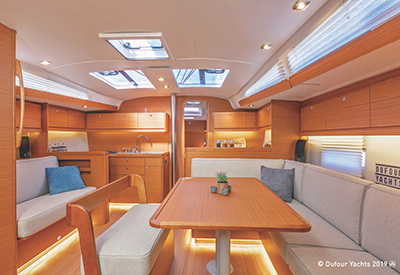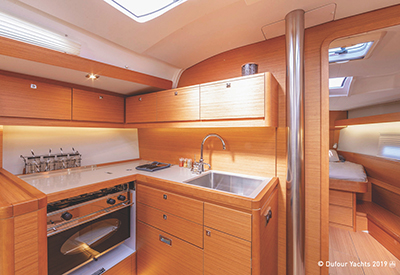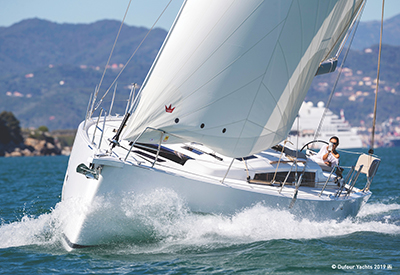Sneak Peek: Dufour 430 Grand Large
Dec 17, 2020
Peter A Robson’s full review runs in February 2021 edition of Canadian Yachting
A top-quality French cruiser that ticks all the boxes
Dufour Yachts was established in 1964, and today the La Rochelle-France based company counts itself among the biggest shipyards in the world. Currently, Dufour produces 11 sailboat models from 31 feet (9.67 m) to 63 feet (19.2 m).
The 430 Grand Large is one of the next generation series Dufours designed by Italian naval architect Umberto Felci. We tested a brand new three-cabin, two-head model with a single spade rudder and twin wheels. Its L-shaped keel is relatively deep with a standard draft of 6′ 9″ (2.1 m). The beam on the 430, like other new next generation models, has been carried further forward than older model Dufours. This means more interior room.
 Belowdecks, the biggest departure from the norm is the forward galley. Putting a galley between the salon and the bow master is only possible because the beam of the 430 has been carried far enough forward to provide the necessary room.
Belowdecks, the biggest departure from the norm is the forward galley. Putting a galley between the salon and the bow master is only possible because the beam of the 430 has been carried far enough forward to provide the necessary room.
Wooden valances run the length of the cabin and not only hide indirect lighting, but double as handrails. Cruisers will also appreciate the ample storage not only throughout the vessel, but also in handy under-deck cabinets (with gas pistons for gentle operation) that run the length of the salon.
 The master’s island queen is surprisingly wide at the head end, thanks to the beam being carried forward. Also unusual is the large divided hanging locker with great hanging space as well as shelf storage. The hull windows offer wonderful visibility from the bed. And of course, the ensuite is an added bonus.
The master’s island queen is surprisingly wide at the head end, thanks to the beam being carried forward. Also unusual is the large divided hanging locker with great hanging space as well as shelf storage. The hull windows offer wonderful visibility from the bed. And of course, the ensuite is an added bonus.
The deck-stepped, aluminum, two-spreader Seldon fractional rig comes with stainless rigging and a split, backstay. Hoisting the fully battened main from the stack pack was made easy thanks to the electric Lewmar T40 winch mounted on the cabin top. The double ended mainsheet was led to the single, easily-accessible manual Lewmar T50 sheet winch fronting each helm. The traveller was fed through the cabin-top clutch arrays that flank the companionway.
Of course, once the 95 percent self-tacking jib was unfurled and sheeted in for close hauled sailing, it needed no attention.
 Steering under sail was a real treat; the helm was silky smooth and well balanced (at least in our light conditions). Upwind in 8 knots of true wind, our speed was between 4.5 to 5 knots and at 10 knots we were making an average speed of just over 6 knots. Those are pretty good numbers for a cruising yacht.
Steering under sail was a real treat; the helm was silky smooth and well balanced (at least in our light conditions). Upwind in 8 knots of true wind, our speed was between 4.5 to 5 knots and at 10 knots we were making an average speed of just over 6 knots. Those are pretty good numbers for a cruising yacht.
SPECIFICATIONS
LOA: 13.24 m / 43′ 5″
Hull length: 12.50 m / 41′
LWL: 11.69 m / 38′ 4″
Beam: 4.30 m / 14′ 1″
Draft standard 2.10 m / 6′ 11′
Draft shallow: 1.75 m / 5′ 9″
Keel weight, standard 2.6 t / 5,732 lbs
Displacement
Light 9.7 t / 21,385 lbs
Engine, std: Yanmar 50 hp Diesel w/Saildrive
Engine, optional: 60 hp
Fuel tank: 250 L / 66 USG
Fresh water: 430 L / 114 USG
Hot water: 40 L / 10.5 USG
Holding: 53 L / 14 USG
Category: European Directive 2013-53-EU Category A
Mast length above WL: approx. 19.2 m / 63′
Total sail area: 92 sqm / 990 sq ft
Main sail: 52 sqm / 560 sq ft
Self-tacking jib: 40 sqm / 431 sq ft
Price as tested: $453,980 Cdn.























